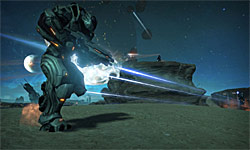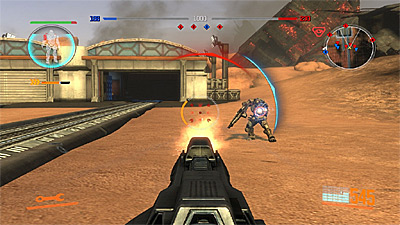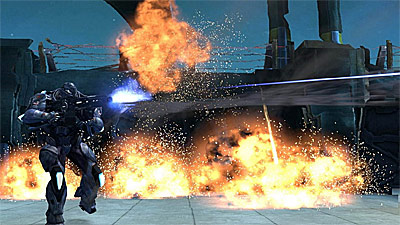A Hunk of Burn-in Love
My time with Section 8 was quite enjoyable. While I don’t see myself clinging to this one past the next several weeks, it’s been a fun romp that I certainly don’t regret. It’s important to know that this game is all about the multiplayer action. In fact, it was designed specifically for online play. The single-player campaign, though entertaining, is essentially a glorified tutorial. If you’re one of those few Xbots that doesn’t have a Gold subscription, or if your broadband connection is lacking for PC gaming, you’ll want to take a pass. For the rest of you, there is a lot of fun to be had, and there are a lot of unique concepts that are well-implemented.

Upon firing up the game, you’ll be presented with a quality cutscene that helps flesh out the setting. Interestingly, the following start menu is headed up by the Multiplayer tab – further evidence that this title is all about online play. However, if you’re the patient or methodical sort, Section 8 does give players a rather short yet surprisingly fun single-player option. The story is definitely light (to be kind), but it gets the job done. Players will take on the role of Alex Corde, a recruit of the 8th Armored Infantry of the United States Empire. Also known as Section 8, an “antiquated” military term for mentally unstable soldiers, this unit is the toughest collection of warriors the US Imperial Army has in its armed forces. This group of futuristic, power suit wearing paratroopers has been called into action to wrest control of various planets away from the invading Arm of Orion – a splinter group of humanity imposing their will on the outskirts of the empire.
While this narrative never really grows beyond the initial setting, it does provide players with a battleground in which to practice. The single-player experience, though extremely linear, introduces you to every preset character loadout, how to capture control points, going about completing combat missions, purchasing deployables, using vehicles, getting around the battlefield, and “burning in.” All of these skills are needed for mastering multiplayer, and by the time you reach the end of Corde’s Story, you’ll be perfectly familiarized with the game’s mechanics.
Moving on to the meat of the title, multiplayer is a unique and fun experience. While it doesn’t rival the best multiplayer games out there, it provides a great and unique experience that’s probably better than all other second-tier shooters out there. What makes the multiplayer portion so good is the emphasis on strategic elements and the teamwork-centric approach.

For starters, players have the ability to spawn with their squad or can free spawn anywhere on the map. By looking at the TacNet (the map and class selection interface), players can choose to “burn in” (drop into the battle from a low planetary orbit) wherever they’d like. This allows you get right back into the action, get close to the objective, perch yourself on a sniper blind, or flank the enemy unexpectedly. This first layer of tactical assessment really sets the tone.
The next bit of strategic goodness has to do with the way the game is set up. Rather than concentrating just on kills, multiplayer matches are won through the accumulation of Victory Points (VP). That means racking up kills is only one small piece of the puzzle. This puts an emphasis on capturing control points, healing comrades and deployed weaponry, and completing the current combat mission. Also, rather than allowing players to choose between different standard match types, the game objectives are ever-evolving. If you are a shooter fan that only appreciates deathmatch variants, Section 8 is likely not for you. However, if you enjoy other game types like escort, CTF, and zones of control, Section 8 has a lot to offer.

The game has each side of the conflict focusing on capturing control points (computer panels and terminals that control strategic equipment such as AA guns and radar towers) and pulling off Dynamic Combat Missions (DCMs). By capturing control zones, not only is your team awarded with a lot more VP than taking out individual players, but you’re also given strategic advantages that allow you to better control the battlefield, giving you the edge. Likewise, combat objectives will constantly be thrown at you and your team. These are complex missions that will net your team major VP. DCM types include Commando (assault an enemy base), VIP (basic escort missions), Outpost (defend a strategic location), Intelligence (nab the intel and return it to a specific point), Bomb (sneak a bomb into an enemy base), and Convoy (pilot vehicles to a specific destination). Needless to say, in order to accomplish these complex goals, you’ll have to work with multiple other players to get the job done efficiently. The combination of racking up kills, sneaking behind enemy lines to wrest control of a zone away from them, and completing more complex missions gives the multiplayer a unique characteristic that’s very enjoyable.
The multiplayer is further enhanced by the ability customize loadouts and purchase deployables. While Section 8 provides players with several different class types, players can actually mix and match these classes’ arsenals in order to create a few über-builds. Not only can you choose between quality weaponry (pistols, assault rifles, machine guns, shotguns, missile launchers, sniper rifles, etc.), you can also give your loadouts two equipment choices (grenades, sticky detonation packs, a repair tool, a mortar launcher, etc.) and ten passive modules that give your power suit constant buffs. These loadouts can be saved and switched out before spawning.

As you start mastering the game, you’ll not only acquire ranks and awards, you’ll also accumulate Requisition Points. These can be used to purchase and strategically deploy various turrets, supply/health depots, tanks, and heavy armor mechs. These deployables allow you and your team to control the battlefield, creating a safe haven for future spawning and for protecting important points on the map.
In terms of presentation, Section 8 makes use of the Unreal Engine 3 to great effect. The action is always nicely captured, the cutscenes are crisp, and the textures and particle effects are nicely rendered. While this isn’t the best game you’ve ever seen, it certainly is no slouch either. Sounds don’t fair quite as well. The music is forgettable and the voice acting, though professionally presented, adds almost nothing considering the single-player campaign is more of a tack-on. Also, while the in-game orders over the comm. system are informative, it can get a bit cacophonous. The sound effects on the other hand support the action perfectly.
Controls are very familiar to those found in nearly every other FPS out there. However, there are a few abilities that mix things up. For example, your power suit comes equipped with a jet pack to boost you around the battlefield. You can also go into a hyper-sprint if the sprint button is held down for a time. Also, you can even lock-on to targets while zooming. All of these heightened powers are limited – you can only use them as long as their energy meters last. The inclusion of these abilities help to differentiate the title from other FPS and emphasize the fact you’re suited up, but they certainly aren’t revolutionary.
Section 8 also includes an Instant Action mode from the main menu, but it essentially just allows you to play in bot matches. As such, it’s rather inconsequential when compared with the true multiplayer and even single-player experience for that matter. When all is said and done, Section 8 is a quality multiplayer experience a lot of players will get into. Unfortunately, the other aspects of the game, while fine in their own right, don’t manage to add much to the formula. As such, this is a game that probably could have been released via the XBLA or Steam for $15 or $20 and would have been a veritable masterpiece. Since it’s a full priced title, you may want to download the demo first and buy later.
RATING OUT OF 5 RATING DESCRIPTION 4.2 Graphics
The game utilizes the Unreal Engine 3 and it shows. 4.2 Control
The standard FPS controls are shaken up slightly by a few clever, if not amazing, game-specific abilities. 3.3 Music / Sound FX / Voice Acting
The music and voice work are passable. The sound effects are the highlight. 3.5 Play Value
This game is almost strictly a multiplayer experience. As such, you’re not getting a whole lot of value for your money. That said, the competitive online play will be worth the price of admission for many. 3.7 Overall Rating – Good
Not an average. See Rating legend above for a final score breakdown.
Game Features:
